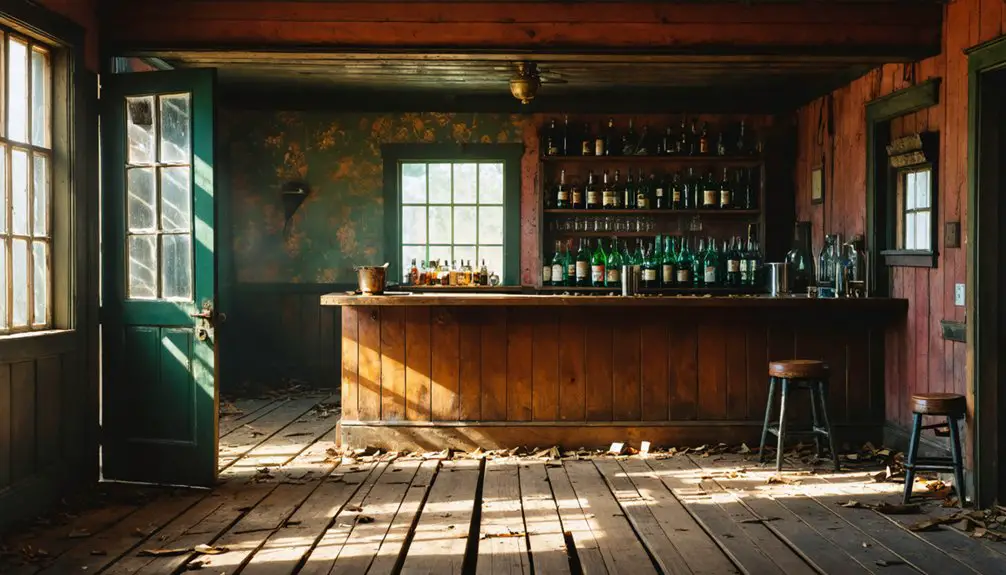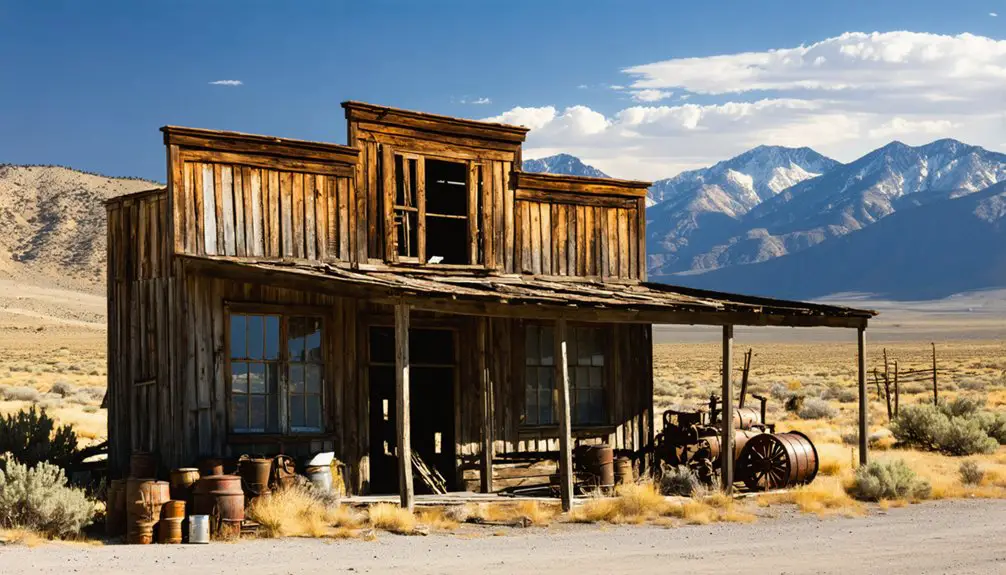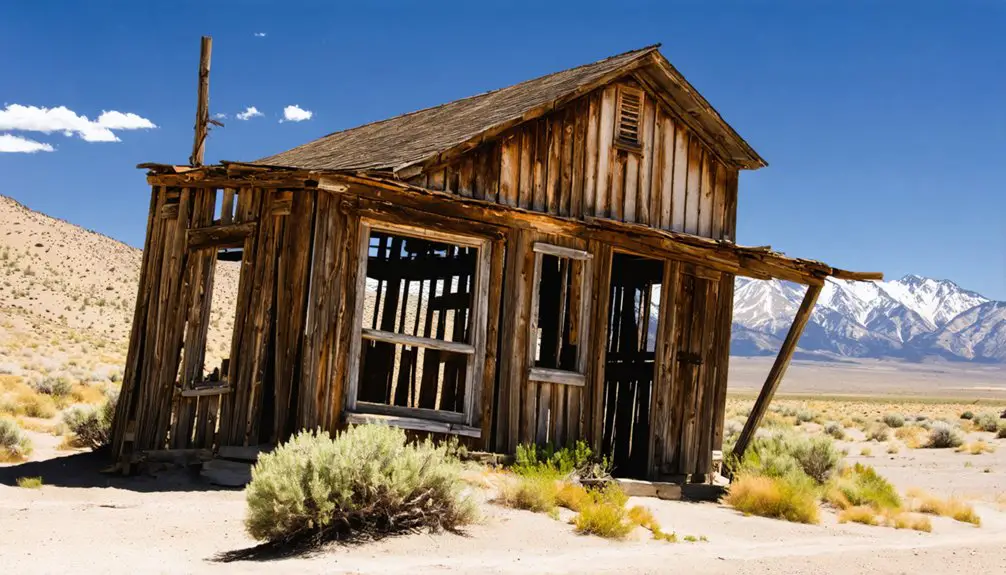You’ll find Ocala among Nevada’s notable ghost towns, born from James Matteson and Frank Heck’s 1872 gold discovery. The settlement flourished after John Versan’s 1877 placer gold find, leading to 300 new claims between Wet and Dry Gulch. An eighteen-mile flume system supported mining operations, but like many boom towns, Ocala couldn’t sustain itself. The town officially became a ghost town in 1941, though its remnants still tell tales of Nevada’s mining heritage.
Key Takeaways
- Ocala became a mining settlement in 1872 after gold discoveries by James Matteson and Frank Heck, sparking rapid development.
- The town thrived on placer gold mining, with 300 claims staked between Wet Gulch and Dry Gulch after 1877.
- An eighteen-mile flume system supported mining operations, demonstrating the town’s significant infrastructure development during its peak.
- Depletion of gold and silver ore, combined with economic challenges during the Great Depression, led to the town’s decline.
- Ocala officially became a ghost town in 1941 when its post office closed, marking the end of its active settlement period.
The Rise of a Mining Settlement
After James Matteson and Frank Heck discovered gold lodes near Ocala in 1872, the area quickly transformed from untamed wilderness into a bustling mining settlement.
While their initial 100 claims on quartz veins proved challenging to profit from, John Versan’s discovery of placer gold in 1877 sparked a true economic boom.
You’ll find that mining techniques evolved as prospectors staked 300 new placer claims between Wet Gulch and Dry Gulch. An ambitious eighteen-mile flume system was constructed to deliver crucial water to the mining operations.
Like many Nevada mining towns, Ocala experienced the typical boom-bust cycles that characterized the state’s precious metals era.
Life in Early Ocala
While gold mining drove Ocala’s economy, daily life in the settlement revolved around tight-knit communities of miners and their families who adapted to frontier conditions.
Without formal law enforcement, residents faced a reality where gun law prevailed, making survival challenging and dangerous.
You’d find yourself living in simple wooden structures or tents, gathering at makeshift saloons and community halls where social gatherings helped ease the harsh realities of isolation. Similar to Boyd’s history, the town supported a thriving lumber company sawmill that provided jobs for many residents.
Community traditions centered around mining schedules, with celebrations occurring on weekends and after paydays.
Miners marked time by the rhythm of work and wages, gathering to celebrate life’s moments between shifts underground.
You’d rely on basic services – a single doctor, limited law enforcement, and dirt roads that often became impassable after rain.
Local merchants operated on credit until payday, while skilled craftsmen provided essential services.
Despite the challenges of extreme weather, scarce resources, and limited healthcare, residents fostered solidarity through cooperative efforts like barn-raisings and shared resource management.
Mining Operations and Economic Impact
You’ll find that Ocala’s mining operations centered primarily on placer gold extraction, requiring elaborate water delivery systems including an 18-mile network of flumes and ditches from Wheeler Peak to overcome the arid conditions.
Like many mining operations during the Great Depression, Ocala faced significant challenges as gold prices fell and production costs increased, forcing many miners to abandon their claims.
The mining workforce adapted to technological shifts as operations evolved from simple placer mining to more complex processing methods, including the adoption of cyanide treatment by the late 1890s.
Despite modest yields, with the Osceola Mining Company reporting just over $16,000 in 1890, the mining activities created temporary economic opportunities that transformed the local settlement patterns until the town’s eventual decline.
Following the pattern of other Nevada mining communities, Ocala’s development was significantly influenced by the Comstock Lode discovery which had established crucial mining infrastructure throughout the region.
Ore Extraction Methods
During Ocala’s peak mining years in the 1880s, hydraulic mining emerged as the primary method for extracting gold from the region’s hillsides.
You’ll find that miners relied heavily on water from the Ocala West and East ditches, though the supply proved insufficient for sustained operations.
The evolution from placer mining to more sophisticated extraction methods reflected the broader technological changes sweeping through Nevada’s mining districts. Like many ghost towns, Ocala’s fate was sealed by the depletion of its ore deposits.
As hard rock mining developed, you’d see both dry and wet milling techniques in use.
While dry milling created dangerous silica dust affecting miners’ health, wet milling techniques improved dust mitigation and ore recovery efficiency.
Despite these technological advances, Ocala’s mining operations couldn’t overcome their water resource limitations.
The lack of sufficient infrastructure and water ultimately restricted extraction efficiency, leading to the town’s decline by 1900. A remarkable nugget worth $6,000 was discovered in 1886, highlighting the area’s rich mineral deposits.
Mining Workforce Demographics
As Nevada’s mining sector expanded into the 21st century, Ocala’s workforce demographics reflected broader industry trends that would later shape the state’s mining landscape.
You’ll find that mining workforce diversity evolved considerably, with women’s representation increasing from 11% in 2014 to 15% by 2024. The industry now employs between 8,400 and 10,000 workers statewide, with racial and ethnic minorities comprising 17% of the workforce. Recent labor data shows mining employment stability at approximately 10,500 workers in the sector.
In leadership roles, women hold 16% of management positions, surpassing the global mining average of 14%. The workforce spans various specialties, from continuous mining machine operators at 13.6% to extraction workers at 5.6%. Following trends seen in West Virginia, the state developed strong specializations in roof bolting operations to enhance mine safety.
This demographic shift coincides with expanded healthcare coverage, now reaching 81% of employees, supporting the industry’s commitment to workforce retention and inclusivity.
Daily Challenges in the Nevada Desert
You’ll face intense daily survival challenges in Ocala’s harsh desert environment, where water scarcity demands careful rationing and secure storage methods to prevent rapid dehydration.
Your body must adapt to extreme temperature swings, where daytime heat soars into the 90s Fahrenheit before plummeting below freezing at night, requiring versatile clothing and shelter strategies.
The barren terrain’s lack of landmarks creates treacherous navigation conditions, making transportation between water sources and shelter locations particularly dangerous without proper planning and equipment.
Water Scarcity and Storage
While Nevada’s stark desert landscape might appear naturally water-scarce, the region’s water challenges have intensified due to unprecedented population growth and climate change.
You’ll find Southern Nevada particularly stressed, consuming 75% of the state’s water despite receiving only 4 inches of annual rainfall. Lake Mead’s water levels have plummeted over 150 feet since 2000, threatening critical infrastructure and forcing aggressive water conservation measures.
You’re looking at a region where groundwater protection has become paramount, with over 25,000 springs supporting unique ecosystems and 300 endemic species.
The Colorado River, supplying 90% of Las Vegas Valley’s water, faces Tier 1 shortage restrictions. With water demand projected to surge 85% by 2065, you’ll need to adapt to mandatory watering restrictions and embrace desert-friendly landscaping to survive in this increasingly arid environment.
Extreme Temperature Survival
Living in Nevada’s unforgiving desert demands a constant battle against extreme temperature fluctuations that test human survival limits daily. You’ll face scorching days above 100°F and nights that plummet 50 degrees lower, requiring strategic heat survival techniques.
During daylight hours, you must minimize UV exposure by wearing breathable, light-colored clothing and frequently reapplying sunscreen, especially at 4,000-foot elevations where radiation intensifies.
Temperature adaptation becomes critical as darkness falls. You’ll need to create windbreaks, dig into the earth for stability, and use reflective materials like survival blankets to maintain body heat.
Your shelter should allow airflow while avoiding flood-prone areas. During peak heat, limit physical activity and take frequent shade breaks to prevent dehydration and heat exhaustion.
Navigate using stars or sun positioning to minimize direct exposure.
Transportation Through Barren Terrain
Traversing Nevada’s barren terrain presents formidable challenges that test both vehicles and travelers daily.
You’ll face transportation challenges ranging from rocky outcrops to sandy washes, while limited water sources and repair facilities compound the risks of remote desert travel.
Historic logistics solutions evolved from horse-drawn wagons to railroads, though many routes eventually fell into disuse as mining operations changed.
- Your vehicle must contend with primitive roads, seasonal flash floods, and tire-damaging desert flora.
- You’re often isolated from emergency services, with limited communication options.
- Railroad remnants, like ties and bridge pilings, remind you of past transportation networks.
Early transportation methods couldn’t overcome these harsh conditions, contributing to the abandonment of towns like Ocala when mining technology and shipping needs evolved beyond their infrastructure’s capabilities.
The Town’s Eventual Decline
Once the easily accessible gold and silver ore began depleting, Ocala’s fate followed the classic boom-and-bust pattern typical of mining towns.
You’ll find that without economic diversification or proper community planning, the town couldn’t sustain itself when mining operations became less viable. The remote location and harsh environmental conditions only accelerated its decline.
As mining costs increased and newer technologies emerged elsewhere, Ocala’s outdated methods couldn’t compete.
You can trace the town’s downfall through the gradual closure of essential services and businesses. The isolation from major transportation routes made it increasingly difficult to maintain supply chains or attract new investment.
The final blow came in 1941 when the post office closed, marking Ocala’s official transformation into a ghost town.
Remaining Structures and Artifacts

Despite years of abandonment and decay, several significant structures and artifacts remain in Ocala’s ghost town landscape.
You’ll find surviving buildings from before the 1940s fire, including houses and a cemetery, alongside remnants of the town’s mining operations. The remaining structures showcase innovative building techniques using local materials like adobe mud and recycled glass bottles.
Throughout the site, you’ll discover evidence of both industrial and domestic life:
- Mining artifacts including pipe sections, cyanide mill remnants, and scattered stone debris
- Household items such as ceramic-top ovens, bed springs, and vintage motor parts
- A historic cemetery with preserved gravesites marking former residents
These physical remnants tell the story of a small but bustling mining community, where residents adapted to harsh conditions using available materials and resourceful construction methods.
Preservation Efforts and Current Status
While the physical remnants of Ocala’s ghost town endure, preservation efforts have largely emerged from grassroots community involvement rather than formal government initiatives.
The site appears to be in a natural state of arrested decay, with limited documented restoration activities compared to other Nevada ghost towns.
You’ll find that preservation challenges in ghost towns like Ocala typically include harsh desert conditions that accelerate structural deterioration, limited financial resources, and the need to balance public access with site protection.
Local enthusiasts and volunteer groups often take the lead in maintaining historical structures, using personal funds and materials for repairs.
When preservation work occurs, it focuses on stabilizing original materials and preventing further decay while maintaining historical authenticity through non-commercial approaches.
Historical Significance to Nevada

As a tribute to Nevada’s mining heritage, Ocala exemplifies the state’s characteristic boom-and-bust cycle that shaped its early economic development.
You’ll find Ocala’s story deeply woven into the fabric of Nevada’s cultural legacy, representing the ambitious spirit of early settlers who sought fortune in the state’s mineral-rich lands.
Key aspects that highlight Ocala’s historical significance include:
Historical markers define Ocala’s legacy, from its bustling mining operations to the diverse community that shaped Nevada’s economic growth.
- Its role as a social and economic hub that attracted diverse settlers, from prospectors to merchants
- The town’s evolution through the shift from individual prospecting to corporate mining operations
- Its demonstration of how transportation infrastructure directly influenced the survival of mining communities
Like many ghost towns, Ocala’s remains serve as a tangible reminder of Nevada’s mining heritage, preserving essential insights into the state’s economic foundations and pioneering spirit.
Visiting the Ghost Town Today
Today’s visitors to Ocala ghost town encounter a raw, unfiltered glimpse into Nevada’s mining past.
You’ll need a high-clearance or four-wheel-drive vehicle to navigate the unpaved roads, as there’s no public transportation to the site. For successful ghost town exploration, bring GPS navigation and physical maps, since local signage is minimal.
The site features dilapidated structures and foundations, offering authentic photography opportunities amid the desert landscape.
You’ll find no visitor facilities or marked trails, so pack sufficient water, sun protection, and emergency supplies. Following visitor guidelines is essential – don’t remove artifacts or vandalize the structures.
The nearest amenities are 20-40 miles away, so plan accordingly. Watch for wildlife, including lizards and snakes, and be prepared for extreme desert temperatures.
Frequently Asked Questions
Were Any Significant Crimes or Notorious Outlaws Associated With Ocala?
While you might expect notorious criminals and outlaw legends from a Nevada ghost town, you won’t find them here – historical records don’t show any significant criminal activity in Ocala.
What Native American Tribes Originally Inhabited the Area Before Mining Began?
You’ll find the Western Shoshone and Northern Paiute tribes originally inhabited this region, with tribal history showing their hunter-gatherer societies and cultural impact through petroglyphs, oral traditions, and seasonal migrations.
Did Any Famous People or Historical Figures Ever Visit Ocala?
Even with today’s GPS tracking, you can’t find records of any famous visitors to this site. Historical significance exists through mining activities, but no documented evidence shows notable figures ever visited.
Were There Any Major Epidemics or Health Crises in Ocala?
You won’t find documented evidence of major epidemics or health crises in the available health records. While mining towns faced typical health risks, there’s no confirmed epidemic impact specific to this location.
What Happened to the Cemetery and Are There Recorded Burials?
You won’t find detailed burial records for this site, as cemetery preservation efforts weren’t documented. The cemetery’s exact location and fate remain unclear in available historical records.
References
- https://www.ocalastyle.com/ghost-towns-of-marion-county/
- https://352today.com/news/257752-defunct-ocala-kerr-city-marion-countys-forgotten-ghost-town/
- https://nevadamagazine.com/issue/winter-2024-2025/25048/
- https://www.youtube.com/watch?v=9EZmsAyiXI0
- https://www.visittheusa.com/experience/6-nevada-ghost-towns-explore-if-you-dare
- https://westernmininghistory.com/towns/nevada/osceola/
- https://www.churchillcountynv.gov/DocumentCenter/View/15536/2020-Master-Plan-Appendix-E-List-of-Historic-Sites-in-Churchill-County
- https://nbmg.unr.edu/mining/MiningHistory.html
- https://nevadamining.org/new-history-page/
- https://savingplaces.org/stories/explore-wild-west-mining-history-in-nevada-ghost-towns



